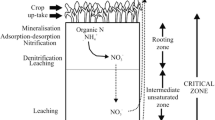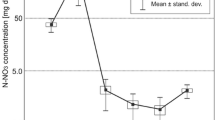Abstract
The simultaneous distribution of water, nitrate, and ammonium from a point source discharging an ammonium nitrate (NH4NO3) solution was measured using the gravimetric method. A 15° wedge-shaped plexiglass container was used to represent one twenty-fourth of the complete cylinder. The variables affecting water and solute distributions, including application rate, input concentration, and applied volume were investigated and their effects are presented on a basis of a completely cylindrical system. In the experiments, the apparent cylindrical application rate was varied from 0.6 to 7.8 l/h, the apparent cylindrical applied volume from 6 to 15 l, and the input concentration from 100 to 700 mg/l. Monitoring of the water movement revealed that the ultimate saturated entry radius on the surface increased with the application rate. Surface wetted radius and vertical wetted depth were proportional to the applied water volume with power values of about 0.3 and 0.5, respectively. The shape of the wetted soil zone was clearly related to the application rate and the applied volume. An increase in rate resulted in an increase in the wetted horizontal area and a decrease in the wetted soil depth, while an increase in volume resulted in an increase in wetted horizontal and vertical areas. A uniform distribution of nitrate concentration in the soil was found 15 cm around the point source for a given input concentration. For any input concentration, the accumulation of nitrate at the boundary of the wetted volume was observed. The nitrate concentration in the soil was primarily affected by the input concentration; there was an increased nitrate concentration with a higher input concentration. The results of ammonium distribution measurements indicated that there existed an extremely high ammonium concentration in the proximity of the point source (about 2.5–7.5 cm from the source). An increased input concentration produced a higher ammonium concentration around the point source. Results also demonstrated that the influence of fertigation on the ammonium distribution was restricted in a small volume, about 10 cm around the point source. Beyond this range, input concentration, application rate, and total applied volume had insignificant effects on ammonium distribution. The information obtained from this research is useful in the design, operation, and management of a fertigation system with drip irrigation.

















Similar content being viewed by others
References
Bar-Yosef B, Sheikholslami MR (1976) Distribution of water and ions in soils irrigated and fertilized from a trickle source. Soil Sci Soc Am J 40:575–582
Ben-Asher J, Lomen DO, Warrick AW (1978) Linear and nonlinear models of infiltration from a point source. Soil Sci Soc Am J 42:3–6
Brandt A, Bresler E, Diner N, Ben-Asher I, Heller J, Goldberg D (1971) Infiltration from a trickle source. I. Mathematical models. Soil Sci Soc Am Proc 35:675–682
Bresler E (1975) Two-dimensional transport of solutes during nonsteady infiltration from a trickle source. Soil Sci Soc Am Proc 39:604–612
Bresler E, Heller J, Diner N, Ben-Asher I, Brandt A, Goldberg D (1971) Infiltration from a trickle source. II. Experimental data and theoretical predictions. Soil Sci Soc Am Proc 35:683–689
Bristow K, Cote CM, Thorburn PJ, Cook FJ (2000) Soil wetting and solute transport in trickle irrigation systems. 6th International Micro-irrigation Congress, Technology for Developing Agriculture, South Africa
Burt C, O'Connor K, Ruehr T (1998) Fertigation. Irrigation Training and Research Center, California Polytechnic State University, San Luis Obispo, Calif.
Butters GL, Jury WA, Ernst FF (1989) Field scale transport of bromide in an unsaturated soil. 1. Experimental methodology and results. Water Resour Res 25:1575–1581
Clothier BE, Sauer TJ (1988) Nitrogen transport during drip fertigation with urea. Soil Sci Soc. Am J 52:345–349
Clothier BE, Sauer TJ, Green SR (1988) The movement of ammonium nitrate into unsaturated soil during unsteady absorption. Soil Sci Soc Am J 52:340–345
Kachanoski RG, Thony JL, Vauclin M, Vachaud G, Laty R (1994) Measurement of solute transport during constant infiltration from a point source. Soil Sci Soc Am J 58:304–309
Khan AA, Yitayew M, Warrick AW (1996) Field evaluation of water and solute distribution from a point source. J Irrig Drain Eng ASCE 22(4):221–227
Laher M, Avnimelech Y (1980) Nitrification inhibition in drip irrigation systems. Plant Soil 55:35–42
Lu D (2000) Experimental study and simulation of water and salt movement in the soil. Master's degree thesis, Xi'an University of Science and Technology, Xi'an, Shannxi, China
Mmolawa K, Or D (2000) Water and solute dynamics under a drip-irrigated crop: experiments and analytical model. Trans ASAE 43:1597–1608
Warrick AW (1974) Time dependent linearized infiltration. I. Point source. Soil Sci Soc Am Proc 39:383–386
Warrick AW (1985) Point and line infiltration: calculation of the wetted soil surface. Soil Sci Soc Am J 49:1581–1583
Wooding RA (1968) Steady infiltration from a shallow circular pond. Water Resour Res 4:1259–1273
Acknowledgements
This work was financially supported by the National Natural Science Foundation of China (NSFC) (grant no. 59979027), the National High Technology Development Plan Project (grant no. 2001AA242032), and the National Key Fundamental Project (grant no. 1999011803).
Author information
Authors and Affiliations
Corresponding author
Rights and permissions
About this article
Cite this article
Li, J., Zhang, J. & Ren, L. Water and nitrogen distribution as affected by fertigation of ammonium nitrate from a point source. Irrig Sci 22, 19–30 (2003). https://doi.org/10.1007/s00271-003-0064-8
Received:
Accepted:
Published:
Issue Date:
DOI: https://doi.org/10.1007/s00271-003-0064-8




